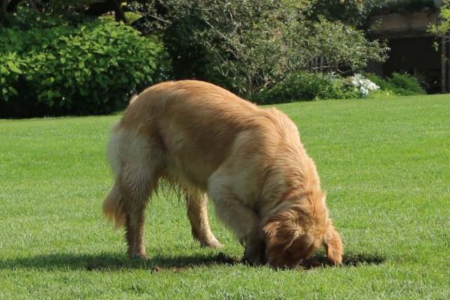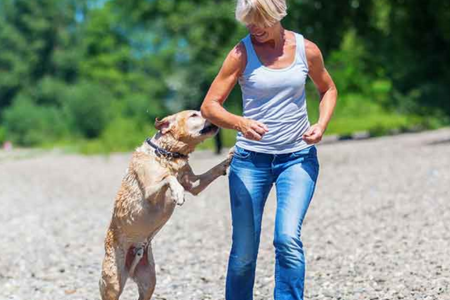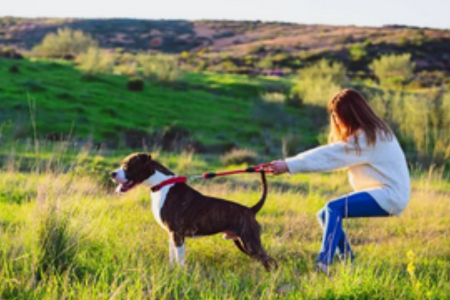The
Ultimate Solution for Common Dog Behavior Problems: Tips and
Tricks from a Professional Dog Trainer
As
a dog owner and lover, I know how rewarding it is to have
a furry companion by your side. But I also know how challenging
it can be when your dog exhibits behavior problems that make
you frustrated or embarrassed.
In
this article, I’m going to share with you some of the
most common dog behavior problems and how to address them
effectively. By understanding the reasons behind these issues
and applying appropriate training techniques, you can improve
your relationship with your canine friend and enjoy a happier
life together.
Barking excessively
Barking
is a natural way for dogs to communicate, but it can also
be annoying and disruptive when it becomes excessive, disrupt
the peace in your household and annoy your neighbors.
Dogs
may bark for various reasons, such as alerting you of potential
threats, expressing excitement or frustration, seeking attention
or affection, coping with anxiety or boredom, or responding
to other dogs. To tackle this problem, you need to identify
the cause of your dog’s barking and tailor your approach
accordingly.

For
example:
-
If your dog barks at strangers or visitors, you can teach
them to associate these people with positive things like
treats or toys. You can also train them to go to a designated
spot like their crate or bed when someone knocks on the
door or rings the bell.
-
If your dog barks when they are excited or want to play,
you can teach them to calm down and wait for your cue before
engaging in the activity. You can also redirect their energy
to something else like a chew toy or a puzzle feeder.
- If
your dog barks for attention or affection, you can ignore
them until they stop and reward them when they are quiet.
You can also teach them to perform an alternative behavior
like sitting or lying down when they want something from
you.
-
If your dog barks when they are anxious or bored, you can
provide them with plenty of mental and physical stimulation
through regular walks, interactive toys, and training sessions.
You can also create a safe and comfortable environment for
them where they have access to their favorite things like
blankets, beds, or music.
Chewing
destructively
Chewing
is a normal behavior for dogs, especially during their teething
stage. However, destructive chewing can result in damaged
furniture, shoes, or personal belongings.
To
prevent this behavior, providing appropriate chew toys is
essential. Choose toys specifically designed for dogs, such
as durable rubber toys or interactive treat-dispensing puzzles.
This will redirect your dog’s chewing instincts to appropriate
objects.

For
example:
- If
your dog chews on furniture or woodwork, you can spray them
with a bitter-tasting deterrent like apple cider vinegar
or lemon juice. You can also block their access to these
areas with baby gates or furniture covers.
- If
your dog chews on shoes or clothing, you can keep these
items out of their reach by storing them in closed closets
or drawers. You can also give them an old shirt or sock
that smells like you as a comfort item.
- If
your dog chews on wires or cords, you can hide them behind
furniture or use cable ties or cord protectors to secure
them. You can also give them a toy that makes noise or lights
up as a distraction.
Digging holes
Digging
is an instinctive behavior for dogs, particularly for breeds
that have a history of hunting or digging activities. Dogs
may dig due to boredom, excess energy, anxiety, seeking comfort,
burying possessions, or attempting to escape. Addressing this
behavior requires a multi-faceted approach.
Provide
your dog with plenty of physical exercise and mental stimulation
through activities like regular walks, interactive toys, and
training sessions. A tired and mentally engaged dog is less
likely to resort to digging out of boredom or excess energy.

For
example:
- If
your dog digs in your yard or garden, you can designate
a specific area for them to dig and fill it with sand or
loose soil. You can also bury some treats or toys in this
area to encourage them to dig there instead of elsewhere.
- If
your dog digs in your carpet or furniture, you can provide
them with a soft and cozy bed or mat where they can relax
and snuggle. You can also spray the areas they dig with
a deterrent like vinegar or citrus.
- If
your dog digs under fences or gates, you can reinforce the
bottom of the fence or gate with chicken wire or concrete
blocks. You can also install a motion-activated sprinkler
or alarm to deter them from approaching the fence or gate.
Jumping up on people
While
it may be adorable when they are young, jumping up on people
can become a nuisance and potentially dangerous as your dog
grows. Teaching your dog appropriate greetings is crucial
to discourage this behavior. To address jumping, train your
dog to sit calmly and wait for attention. Ignore your dog
when they jump up and reward them when they sit down or greet
calmly.

For
example:
- If
your dog jumps on you when you come home, you can turn your
back and walk away until they calm down. You can also ask
them to sit and give them a treat or a toy when they do.
- If
your dog jumps on guests or strangers, you can put them
on a leash and ask them to sit before allowing them to meet
anyone. You can also instruct the person to ignore your
dog until they stop jumping and praise them when they greet
politely.
- If
your dog jumps on children or elderly people, you can teach
them to stay away from these groups unless invited. You
can also supervise their interactions and intervene if they
get too excited or rough.
Pulling on the leash
Walking
a dog that constantly pulls on the leash can be challenging
and tiring. By employing positive reinforcement techniques,
you can teach your dog to walk politely by your side.
Start by using a front-clip harness or a head collar, which
provides better control and discourages pulling. Whenever
your dog begins to pull, stop walking and wait until they
return to your side. Reward your dog with treats, praise,
or a clicker when they walk beside you or make eye contact.

For
example:
- If
your dog pulls towards other dogs or people, you can teach
them to focus on you instead of the distractions. You can
also use a cue like “watch me” or “look”
to get their attention and reward them when they do.
- If
your dog pulls towards objects or smells, you can teach
them to leave it or drop it when they encounter something
interesting. You can also use a cue like “let’s
go” or “this way” to redirect them and reward
them when they follow you.
- If
your dog pulls towards destinations or locations, you can
teach them to wait or stay when they reach a certain point.
You can also use a cue like “ok” or “free”
to release them and reward them when they obey.
If
you find these common dog behavior problems persist despite
your best efforts, it may be beneficial to seek assistance
from a certified dog trainer. A professional trainer can provide
personalized guidance and tailored solutions to address your
dog's specific behavior issues effectively.
Remember,
a well-behaved dog not only brings joy and companionship but
also ensures a safer and happier environment for both you
and your furry friend. With patience, consistency, and appropriate
training techniques, you can overcome these behavior challenges
and foster a strong bond with your canine companion.
______________________________________________________
Discover
the power of Brain Training for Dogs! Unleash your dog's hidden
intelligence, solve behavior issues, and teach amazing tricks.
Join
now and unlock your furry friend's full potential.
Train smarter, not harder, with Brain Training for Dogs...
Click
here!
______________________________________________________
|

